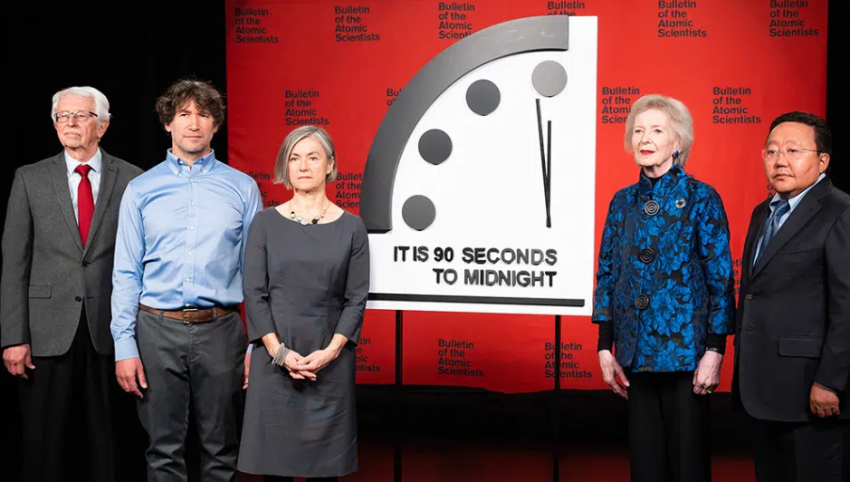
The Doomsday Clock has crept the closest it is ever been, as the Bulletin of the Atomic Scientists set the minute hand to 90 seconds to midnight on January 24, with 12am symbolising Armageddon.
In the wake of the nuclear bombing of Hiroshima and Nagasaki, and the realisation that humanity had the ability to wipe itself out, scientists from the Manhattan Project, the United States research group that produced the first nuclear weapon, established the clock to warn of any rising existential threats.
This year the clock is set at “the closest to global catastrophe” it has ever been. This is chiefly due to Russia’s war in Ukraine and the rising threat of nuclear conflict, coupled with the escalation in the climate emergency, and a “breakdown of global norms and institutions” that can allay technological and biological threats.
The proposition that humanity is in pursuit of its own end is in keeping with the general trend of recent years.
The clock crept to its then closest point in 2018, two minutes to midnight, and sat there for two years — symbolising the dual threats of climate and nuclear annihilation. For the last three years it has been set at 100 seconds.
Bulletin editor John Mecklin said the chief reason for mounting global insecurity is Russia’s war in Ukraine, which is “undermining European security arrangements that have largely held since World War II” and is further eroding “norms of international conduct that underpin successful responses to a variety of global risks” including international mechanisms designed to deal with such crises.
“And worst of all, Russia’s thinly veiled threats to use nuclear weapons remind the world that escalation of the conflict — by accident, intention or miscalculation — is a terrible risk,” Mecklin said. “The possibility that the conflict could spin out of anyone’s control remains high.”
Russia’s war on Ukraine includes the targeting and takeover of the Zaporizhzhia nuclear power plant, Europe’s largest nuclear facility, which risks it being cut off from its power supply and that could result in another Chernobyl-style disaster.
The war has also exacerbated the climate crisis, as countries reliant on Russian oil and gas have had to diversify their sources, leading to a significant global gas industry expansion.
Mecklin said that the last remaining nuclear treaty between the US and Russia — New START — is now in jeopardy unless the two countries resume negotiations. The treaty expires in 2026. If the treaty expires it “would eliminate mutual inspections, deepen mistrust, spur a nuclear arms race and heighten the possibility of a nuclear exchange”.
There are other concerns, including the possibility of China, North Korea and India expanding, and Iran increasing its uranium enrichment capabilities and the US, Russia and China modernising their weapons’ arsenals.
Global carbon emissions are at an all-time high, while extreme weather events, attributable to climate collapse, continue to devastate communities. Extreme heat plagued the northern hemisphere last year, and a third of Pakistan flooded.
The Bulletin of Atomic Scientists further warned that pandemics are likely to rise as more diseases jump from animals to humans. On the technology front, cyber-enabled disinformation continues to circulate as emerging surveillance technologies threaten human rights.
[Paul Gregoire writes for Sydney Criminal Lawyers where a version of this article first appeared.]